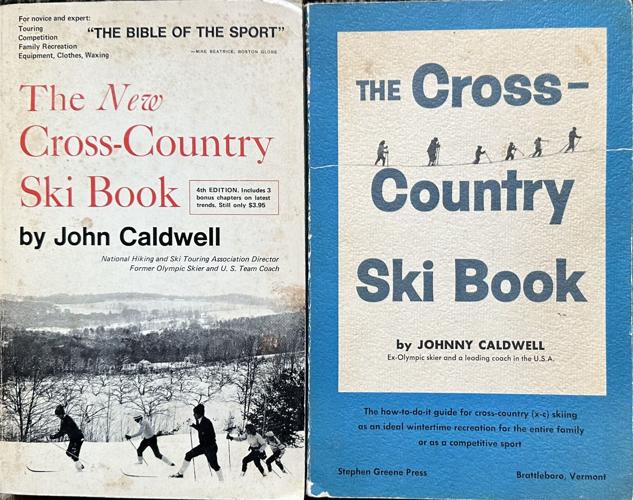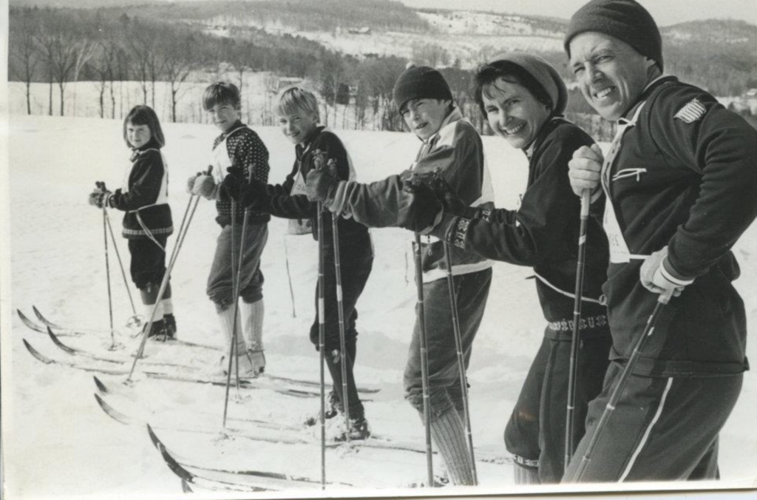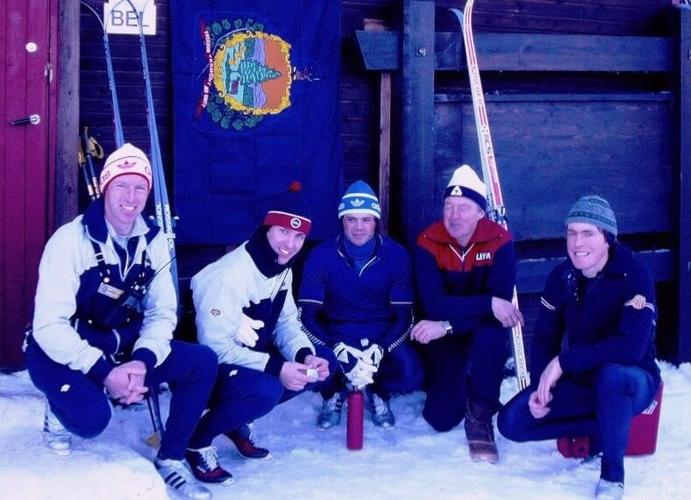HANOVER, N.H. — As the winter chill begins to fade and the snow recedes from the slopes and trails of Southern Vermont, it's a good time to look back on the history and legend of one of the area's favorite sports and recreational activities: cross-country skiing.
And that legend begins and ends with John Caldwell, who has been hailed by cross-country ski enthusiasts as the "father," "godfather," even “guru” of their sport. After all, he wrote the book on it: 1964’s "The Cross Country Ski Book." It was the first time anyone had ever written a guide in English.
"It’s out of print now — it went through seven or eight editions. It was a bestseller," John, now 96, said last week. "I think it sold over 500,000 copies. It’s the only reason I’m not in the poorhouse."
Caldwell competed in the 1952 Winter Olympics and coached the U.S. cross-country Olympic teams in 1960, 1964, 1968, 1972, and 1984. He also coached at the Putney School from the mid-1950s until his 1989 retirement. Among the Putney students and others that he coached were Olympians Bob Gray, Martha Rockwell, Mike Gallagher, his son Tim Caldwell, and Brattleboro's Jim Galanes, Stan Dunklee and Bill Koch, the first American to medal in cross country skiing.
Another son, Sverre, followed in his father’s footsteps, setting up the Stratton Mountain School (SMS) cross-country program and the SMS Elite Team.
Caldwell, a longtime Putney resident, now lives in a retirement community in Hanover, N.H., just up the road from Dartmouth College, the school that he and all four of his children attended and competed in cross-country skiing.
Caldwell says his first skiing recollections go back nearly 90 years, to the mid-1930s when his family lived in Somerset, Pennsylvania.
"My folks gave me a pair of skis for some reason — wood, no edges, and with toe straps. There was not a lot of snow in town and I knew of no other skiers. I stepped into the skis and started down this long hill in some fairly deep powder. I coasted to a stop, fell out of the toe straps, picked up the skis and climbed back up the hill. Next time down I went farther because the trick was to follow the original tracks and so I went faster. Fell down, found my skis, climbed back and probably did one more trip. That was the end of the start of my skiing career."
In 1941, the family moved to Southern Vermont, where John’s father had gotten a job as a business manager at the Putney School, a progressive boarding school that sits on a hilltop dairy farm. Basketball had been John’s sport of choice, but Putney didn’t have a team. It did have a downhill ski team, which John’s dad convinced him to join. The team went to a state ski meet in the winter of 1945-46 and needed a cross-country skier.
"I volunteered, got hold of my sister’s five foot wooden Alpine skis, adjusted the bindings to my very flexible downhill boots (which also doubled as jumping boots) and I was ready to go. We went off to the state meet and did well enough to qualify for the New England Championships the next weekend. I thought I should get serious about training for cross-country and went out one day in the week preceding the New England's. I got tired after a few minutes of thrashing around and quit, went to the New England's and finished 48th out of 52. Those three days on my sister’s alpine skis were the end of my high school cross-country career."
Like many Vermont kids at the time, Caldwell learned the four winter sports: alpine and cross-country skiing, ski jumping and biathlon, and competed in all four when he went on to Dartmouth. For the first time, he got a real pair of cross-country skis and a bit of instruction. As a senior, he went to a Nordic combined ski meet, a mix of ski jumping and cross-country. He beat some guys who’d made the Nordic combined world championship team. "So I tried Nordic combined the next year and made the Olympic team in '52."
Caldwell said he was not well-prepared for his first Olympic experience. His last-place finish (out of 22 competitors) at the Games in Oslo, Norway gave him the incentive to make sure no American would ever suffer that kind of disappointment again.
Over the next 20 years, after returning to the Putney School as a math teacher and coach, he pulled together a legendary cross-country team that included his son Tim, as well as Bill Koch. In 1972, Caldwell’s team pioneered the use of one-piece uniforms. In 1976, Koch won Olympic silver in the 30 kilometer race and still holds the speed record for that event. “In the 1980 Olympic relay, we had my son Tim, Bill Koch and two Brattleboro boys, Stan Dunklee and Jim Galanes. At the time, there were only 37 members of the Putney Ski Club and membership was $1.”
Caldwell also helped coach Canadian biathlete Willie Carroll, Dan Simoneau and National Geographic explorer Ned Gillette. “I always tried to make it fun,” he said. “One summer I got together a group of skiers (including Gillette) and we hiked the Long Trail, end to end, in nine days – hiking out to friends’ houses to stay overnight then back to the trail so we wouldn’t have to carry gear.”
Galanes, a three-time Olympian and 12-time national champion in cross-country and Nordic combined, said Caldwell was a "really great coach, not so much being a hands-on coach, but working on technique skiing, thinking differently about training, trying new things. Bill Koch was a great innovator, but part of that innovation stems from Bill's relationship with John Caldwell and Bob Gray and all the other people around. It fostered in us an ability to really think and question and challenge what we were doing. We certainly didn't always get it right but we were always thinking about it."
John and his wife Hester — "Hep," for short — naturally made cross-country skiing a big part of family life, putting their four children on skis even before they started walking. "They would ski around on the rugs in the living room. They liked that."
Sverre says it was never a high-pressure thing — even with a high-profile dad.
"I don't remember going, 'Oh, my dad's a big deal skier," said Sverre, 70, who now lives in Peru, Vermont. "We just kind of all did it as a family. In elementary school, he built a trail so we could ski down to school. It was probably about 10 kilometers, but mainly downhill. And back then we really didn't race much at all. I'm sure I never beat my older brother (Tim) in a race. My younger brother Peter and I would go back and forth, but I don't remember it as being a big stress point at all.
"I'm lucky in that I never felt any pressure or anything," says Sverre, who is now retired from coaching and teaching at Stratton. "It was just like I was brought up doing it. I enjoyed doing it. I actually was not a great competitor, but then in college I started helping coach a little, and I loved it, so I learned coaching. The sport's been good to me. I've enjoyed it all."
Tim Caldwell would go on to compete in four Olympics, finishing sixth at the 1976 Winter Games in Austria. Sister Jennifer, who passed away in 2011, won the American Birkebeiner, the largest cross-country skiing race in North America.
John's nephew, Zachary, is the founder of Caldwell Sports and a leader in cross-country ski training and equipment. Zach and his wife, Amy, operate West Hill Ski Shop in Putney.
But no one has kept the Caldwell Olympic connection going more than Sverre and wife Lilly's daughter, Sophie, who graduated from Stratton in 2012 and became the third Caldwell to ski in the Winter Olympics, in 2014 in Sochi, Russia. She was in position to contend for a medal midway through the final of the freestyle sprint when she collided with a fellow competitor, causing her to crash and finish sixth.
Sophie got her first victory in the World Cup during the 2016 edition of the Tour de Ski. She won the classic sprint in Oberstdorf, Germany in 2016, becoming only the second American woman with a World Cup victory, and the only one with a classical win.
It's all very gratifying to the matriarch of the family. "It makes me feel good," says John, who is working with Sverre and Zach on an "addendum" of sorts to his book, detailing changes in equipment and techniques over the last 25 years. "And I'm happy that my kids and grandkids and nieces and nephews have taken up the sport."
He's also happy that they've stayed true to his "main pitch" about cross-country skiing, as outlined in page 7 of the third edition of his "bible":
"Cross-country skiing should be fun for everyone," Caldwell wrote. "The range of possibilities for enjoyment is unlimited. You can ski anywhere there's snow, you can use a wide variety of equipment, you can ski alone or with a group, you can use the very best technique while wearing the clothes you just picked up from the local rummage sale, or you can wear the latest styles and invent your own technique. So pick out and use anything you want from this book — but most of all, have fun skiing x-c. Make it be your thing."
It certainly has been Caldwell's — and his family's — "thing" for nearly a century.












